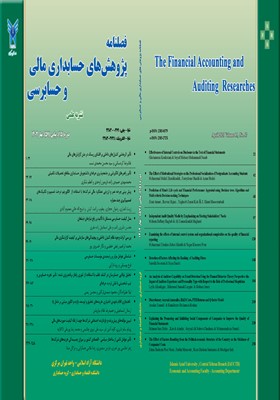بررسی اثر نامتقارن انحراف از بدهی هدف و گردش مالی بر سرعت تعدیل ساختار بهینه سرمایه
محورهای موضوعی : حسابداری مالی و حسابرسیمحمد ابراهیم رابطی خطیبی 1 , نگار خسروی پور 2
1 - گروه حسابداری، واحد تهران مرکزی، دانشگاه آزاد اسلامی، تهران، ایران
2 - گروه حسابداری، واحد تهران مرکزی، دانشگاه آزاد اسلامی، تهران، ایران
کلید واژه: ساختار بهینه سرمایه, گردش مالی, کلمات کلیدی: انحراف از بدهی هدف,
چکیده مقاله :
چکیدهتعیین ساختار بهینه سرمایه، یکی از مسائل اساسی تأمین مالی شرکت ها به شمار می رود. این مهم، کاربرد با اهمیتی در زمینه تصمیم گیری راجع به تأمین مالی عملیات جاری و طرح های سرمایه گذاری شرکت ها دارد. به دلیل کمتر بودن ریسک اوراق بدهی، بازده مورد انتظار اعتباردهندگان نیز کمتر از بازده مورد انتظار سهامداران است. بر اساس نظریه توازن پویا، بدلیل وجود هزینه های انحراف از ساختار سرمایه و هدف و هزینه های تعدیل به سمت این ساختار، ساختار سرمایه شرکت ها لزوما همواره منطبق با هدف نیست. شرکت ها با در نظر گرفتن این هزینه ها، زمانی به تعدیل ساختار سرمایه اقدام می کنند که مزایای ین اقدام از هزینه های مربوط بیشتر باشد. هدف اصلی تحقیق حاضر، بررسی اثر نامتقارن انحراف از بدهی هدف و گردش مالی بر سرعت تعدیل ساختار بهینه سرمایه در 119 شرکت پذیرفته شده در بورس اوراق بهادار تهران برای دوره زمانی 1399-1388 با استفاده از روش پانل گشتاورهای تعمیم یافته می باشد. نتایج تحقیق نشان می دهد در شرکت های که اهرم واقعی بالاتر از اهرم هدف بوده سرعت تعدیل اهرم بیشتر خواهد بود. همچنین شرکت های که گردش مالی مثبت دارند، سرعت تعدیل اهرم بیشتر خواهد بود؛ در نتیجه عدم تقارن گردش مالی از عوامل موثر بر سرعت تعدیل اهرم است. بنابراین بر اساس نتایج شرکت های که اهرم بالاتر یا پایین تر از هدف است، مازاد وجوه نقد نسبت به کسری وجوه نقد منجر به تقویت سرعت تعدیل شده است. بطور کلی یافته های این پژوهش شواهدی در حمایت از تئوری توازن پویا فراهم می کند.
Abstract: Determining the optimal capital structure is one of the basic issues of financial provision of companies. This matter has an important application in the field of decision-making regarding the financing of current operations and investment plans of companies. Due to the lower risk of debt securities, the expected return of creditors is also lower than the expected return of shareholders. The main goal of this research is Investigating the Asymmetric Effect of Deviation from Target Leverage and Asset Turnover on the Optimal Capital Structure Adjustment Speed. the data of 119 companies during the years 2010 to 2021 were analyzed using the using the method of generalized moments. The results of the research showed that considering that the difference in speed between these two modes is statistically significant, it can be said that, consistent with the trade-off theory, deviation from the target lever is one of the factors affecting the Structure Adjustment Speed. Also, the results show that the speed of leverage adjustment will be significantly higher in companies that have a cash deficit compared to other companies. Also, examining the interactive effects of two variables, deviation from the target leverage and turnover imbalance on the capital structure adjustment speed, shows that in companies whose leverage is higher than the target and facing cash surplus, the annual adjustment speed is 88%, and in companies with leverage is lower than the target and facing a cash deficit, the speed of adjustment is not significant, and in companies whose leverage is higher than the target and facing a cash deficit, the annual adjustment speed is estimated at 59%. Therefore, based on the results of the companies whose leverage is higher or lower than the target, the surplus of cash funds compared to the deficit of cash funds has led to strengthening the adjustment speed.
منابع
_||_


